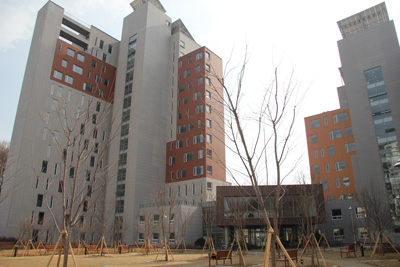It took roughly 18 months to build the new Narae and Mir Halls for students in KAIST. Standing tall among many other dormitories in KAIST, the building housing these halls is located behind Bachelors Housing-1. Covering a plot of 5,602 m2 and a building area of 1,535 m2, the building is composed of just the two Halls. Narae Hall, built for female students, goes up to the 9th floor while Mir Hall, to which male students are assigned, has 15 floors, excluding the basement for both Halls. Unlike most dormitories that have a couple of public washrooms on each floor, all rooms in Narae and Mir Halls have their own washrooms. The majority of the rooms are for two peoples, although there are a few single rooms. Moreover, not only are there study rooms and exercise rooms which students can use to study and work out at their leisure, but there also are rooms for people with disabilities.
Both Narae and Mir Halls have a meaning behind the name. Narae holds the image of spreading wings of imagination and Mir, meaning dragon in pure Korean, has the message of flying high like a dragon.

From July 2009 to December 2010, apartments for foreign professors and great scholars who are invited to KAIST were built. Divided into three buildings, A, B, and C, and covering a gross area of 16,545 m2, the tallest of the three buildings goes up to the 15th floor. In addition, of a total of 152 rooms from all three buildings, 117 rooms are already occupied. There are different sized rooms ranging from 49.5 m2 to 138.6 m2. Though building C opened its doors first, building A has more than twice the number of occupants. Building B is accommodating one person as of February 10, 2011. The professors and scholars are from various different nations that include Armenia, Belgium, Bulgaria, Canada, China, India, Korea, Philippines, Russia, Senegal, Turkey, and the United States.

